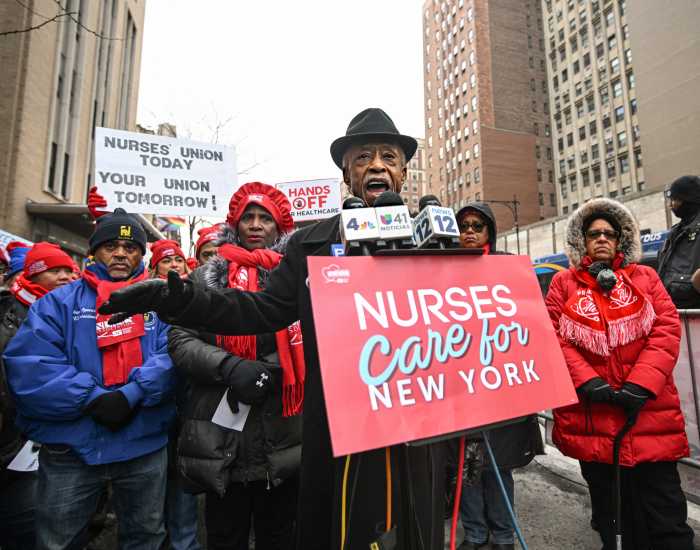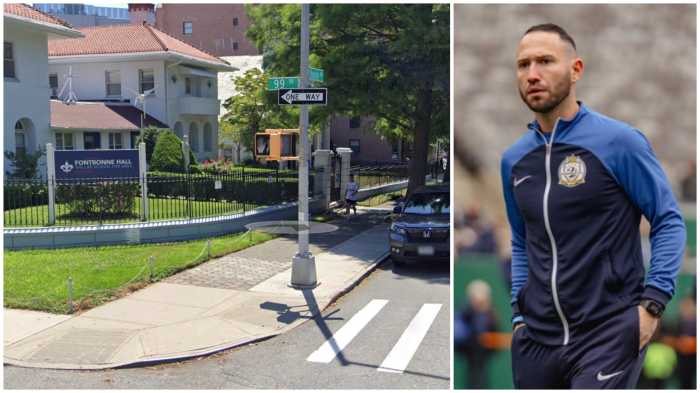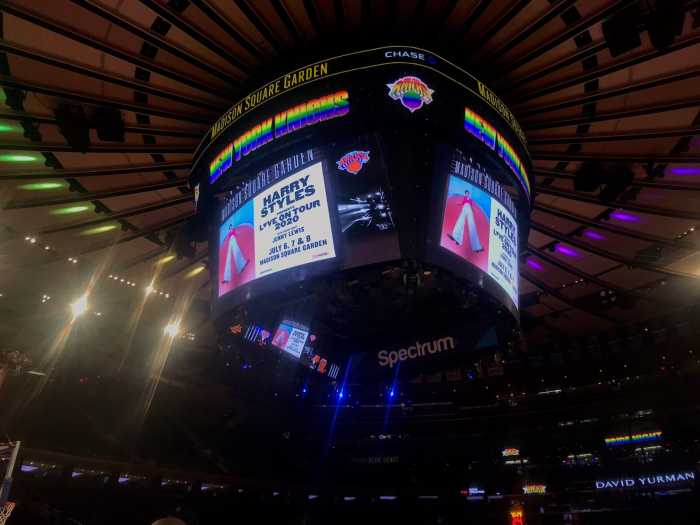BY BONNIE ROSENSTOCK | The beleaguered residents of the Chelsea Hotel marked their first Housing Court victory on Friday, December 16 when Judge Peter Wendt ruled that the new owner must provide measures to ensure their health and safety during major renovations and construction of the iconic landmark’s interior. Judge Wendt directed that the landlord, Joseph Chetrit, adhere to a tenant safety plan and follow all applicable state and local laws and regulations regarding construction and demolition. The so ordered stipulation also required that he agree to provide heat and hot water as required by law.
“It was very successful for the first day in court because the landlord is now under order to provide these services and comply with all the laws,” stated attorney Janet Ray Kalson of the firm Himmelstein, McConnell, Gribben, Donoghue & Joseph — who, along with associate Ron Languedoc, is representing the Chelsea Hotel Tenants Association. She explained that during construction and demolition, workers were opening windows to get rid of the dust. “Our clients recorded temperatures in the 40s and 50s, not in the entire building, but areas where the construction was happening.”
One of the biggest problems is mold, so the tenants are going to get contractor estimates for cleaning it up. They will give the estimates to the landlord — who, if he agrees, will pay for the mold to be remediated. “Hopefully, we will have an agreement about the mold and other hazardous conditions at the premises. There are also issues with silica, lead and large amounts of dust and concerns about asbestos,” Kalson reported.
“Theoretically, the landlord provides safeguards, so tenants can safely occupy their apartments. In practice, we have often found when landlords do construction, they do it in total disregard for the health, safety and welfare of the tenants,” she added.
Chelsea Now visited the Chelsea Hotel (at 222 West 23rd Street, between Seventh and Eighth Avenues) on December 27 to meet with Mary Anne Rose and Zoe Pappas, spokespersons for the tenants association steering committee, in the latter’s cheerful studio apartment, which she shares with husband Nick and three raucous rainbow lories. Stripped of its artwork by former and present residents, the lobby looked desolate — save for a ceramic sculpture of a girl on a swing (Renate Göbel, 1986) suspended from the ceiling, and Rene Shapshak’s bas-relief of the seven arts over the fireplace.
The Chetrit Group and junior partner Clipper Equities took over ownership of the hotel on August 1, 2011, after paying a reported closing price of $77.8 million. The sellers were the offspring of a partnership that had managed the hotel since the 1970s.
“The new owners never said hello, never said their plans, did not accept many of our first month’s rent, then started eviction proceedings, and the next thing we know, they are coming in and demolishing the building around us,” declared Rose, an artist and widow of African-American artist Herbert Gentry.
As a response to the owners’ actions, the tenants organized and formed the Chelsea Hotel Tenants Association on October 7, 2011. Members represent approximately 39 units (some apartments have been combined and reconfigured over the years, and some people have more units). The 12-story red brick building, which opened in 1884, has about 100 units, a mix of Class A (with kitchens and bathrooms) and Class B (more like hotel rooms). The owners are renovating all the vacant apartments and rooms. Currently there are around 80 units because some 15 to 20 tenants left for different reasons, explained Pappas, a structural engineer by profession and classical pianist and painter. “But if you put everything together, there are about 55 percent of us fighting and organized.”
There are two major issues, she explained. “When they bought the building, they knew it was inhabited. They bought it perhaps because it was not well maintained and at a peanut price. But this building is much more valuable even with maintenance issues. It has a lot of commercial space and a lot of commercials and movies are made here. So they thought, ‘Let’s grab it and destroy it.’ Their real intention on a longer term is to eventually throw all of us out. So they started to demolish it like 200 years ago in the Wild West, to create such an unpleasant environment that eventually we might leave. The second issue is not cashing checks. They are warehousing tenants’ checks, sending eviction notices and bringing them to court.”
On the environmental conditions, the first step taken by the association (on the advice of counsel) was to get an environmental assessment. They hired Olmsted Environmental Services, Inc., out of Garrison, NY. The resultant comprehensive report (including pages of test analyses and photos of glaring violations), dated November 2, 2011, a copy of which Chelsea Now obtained, was based on measurements taken during gut renovations of apartments as well as common areas, including the demolishing of half of the seventh floor.
Rose noted that there is a “mole” in the building, who told management that they were bringing in somebody to do some testing, so they started cleaning all day. “Our guy came around 5:30pm, when they weren’t cleaning. The specialist went inside around 25 apartments. Some had the same issues. He discovered all types of mold, and lead was 40 times what it should be.”
Workers had also broken a pipe on the seventh floor, which ran into an association member’s downstairs apartment all weekend. She was out of town and when she came home, there was mold everywhere. “She tried to live there but got sick and her doctor forbade her to do so. She still can’t,” said Rose.
The report stated, “No effort was made by the construction contractor or landlord to aggressively dry the sixth floor water damaged apartments [following standard industry practice]. This [particular] apartment…is uninhabitable.”
The report’s detailed conclusions said that the work in the building is causing excessive amounts of dust to enter the occupied areas and apartments where residents walk. “The dust contains lead…as well as crystalline silica. The work has disturbed lead based paint. Wipe tests reveal very elevated levels of lead contamination in common areas. The contractor did not notify the residents of the lead hazards as required by the US EPA. There are significant fire hazards and a blocked exit route caused by the construction. There is also mold in portions of the building.” (“Visible heavy mold growth” was noted in several apartments.)
Rose said that many pipes have broken as of late, and that El Quijote, the Spanish restaurant next door at ground level, has been flooded three times. “Not that a pipe never broke before, but we never had this collection of activity from week to week. We didn’t want to leave our apartments because every week there was another hysterical event,” she said.
On November 7, when aides from the offices of City Council Speaker Christine Quinn, state Senator Tom Duane, state Assemblymember Richard Gottfried, Rep. Jerrold Nadler and Borough President Scott Stringer came for a tour, they were greeted with an especially odious smell coming from a steam leak from an empty apartment on the eighth floor, with the presence of mold. “They were walking through the dust and coughing,” said Rose. “Management downstairs didn’t find out about their visit, so there was no cleaning and they were demolishing like hell.”
A January 5 email from Quinn’s office stated, “We are continuing our work to ensure safe conditions in the building while protecting the rights of tenants.”
Chelsea Now was also taken on a walking tour from the second to eighth floor while heavy construction was going on. Rose explained that doors painted white indicated an empty apartment, which would be renovated. A sheet of protective plastic (per court order) covered entrances to alcoves that lead to occupied apartments. Rose pointed out the cracks and holes in walls and ceilings caused by the demolition and uncollected debris in the hallways. The judgment says that her rundown apartment must be dealt with. “You can’t blame the new people, but they bought the problem and they are responsible,” Rose declared.
This reporter is allergic to dust and mold and unwittingly became the empirical canary in the coal mine. It began with sneezing, sniffling and belabored breathing and moved on to coughing and runny nose. We took the elevator back to Pappas’ apartment. “You got a small taste of what we are going through,” said Pappas.
On the eviction front, the owners have brought over 20 people to court. Sam Himmelstein, a partner in the above-mentioned law firm, who is defending two of the tenants, explained that most of the cases are “holdover cases” in which the landlord alleges tenants are not stabilized. “The notion that they are not going to change the character of the hotel, that they are going to respect the tenants and their tenancies is pure nonsense and what I would call ‘good public speak,’ but just totally false. I was assured by Michael Brown [the attorney representing owners in the eviction cases] from Day One that they would respect the rights of tenants, but it’s proven false.” (Fred Daniels is defending the owners in Housing Court.)
Tenants flocked to the New York State Division of Housing and Community Renewal (DHCR) at 33 Beaver Street to check if their apartment had been registered. Rose said there was no status on her apartment, but she knows it’s rent stabilized. “Many people’s apartments didn’t even exist,” she asserted. Pappas discovered that the landlord registered some of the apartments after they formed the tenants association.
Kalson said, “They are trying to get out whoever they can, however they can. I happen to know they refuse to accept checks from some people. If the tenant is living with somebody, they’ll only accept checks from the person they acknowledge as the tenant and not the other individual, and they end up starting an eviction case. Thus far, the landlord has been unable to prove tenants are not rent stabilized. But the tenant still has to go to court and go to the expense of hiring a lawyer, so it’s an ordeal.”
Himmelstein is not the lead attorney for the demolition issues. Judge Wendt, who is hearing the case, used to be his law partner and recuses himself from Himmelstein’s cases. (The same judge sees a case through from beginning to end.) “However, from what I understand, the situation has improved somewhat since we got the court order, but there are still problems,” Himmelstein said. “The court case is the result of my trying for weeks to get the landlord to sit down and talk with us, and they kept canceling meetings they had previously scheduled. We finally felt the only way to force their hand was to bring a court case.”
“I believe that doing renovations the way they are doing them — causing a tremendous amount of dust, debris, noise, mold contamination in some apartments, evicting people who are rent stabilized or attempting to evict them, refusing to meet — I would call that harassment,” Himmelstein charged.
Kalson concurred. “Whether it’s the legal definition is a somewhat complicated question. In fact, we didn’t actually sue for harassment; we sued to get all these conditions corrected. But if work is endangering the health, safety and welfare of tenants, you could certainly call it harassment,” she said.
Pappas had another name for it: perverse cruelty. “We are not attacking their right to upgrade the building because it’s necessary,” she acknowledged. “But the disrespect towards the tenants, people who are old, people who have young children, they thought it’s normal. What they don’t get is what made this building what it is is not the interesting façade, but the people who came here.”
On December 30, Pappas informed Chelsea Now that the workmen had just brought out debris uncovered, contrary to Department of Buildings (DOB) and Environmental Protection Agency regulations and the court order. “The court order stated that debris had to be taken out covered so as not to contaminate the hallways, lobbies, elevators and the streets and endanger people with toxic dust,” said Pappas. “They complied for several days and then stopped.”
Pappas said that at one time there were 20 dumpsters outside, and “the whole street was white with misery. It was just unbelievable.”
They also haven’t obtained a plumbing permit, and the DOB “seems to be blind,” according to Pappas. “It’s important to say we are talking about facts, which are difficult to cover up. From the Department of Housing Preservation & Development website we have found 103 violations — 30 class C, which are very bad, 42 class B and others, just regular. It’s about doing things with respect and within the law,” she said.
The Chelsea Hotel Tenants Association and owners will return to court on Thursday, January 19, where one of two things will transpire, explained Kalson. “Either we will enter into a comprehensive agreement for the correction of all the violations and hazardous conditions of the building, or we will be at an impasse, in which case we will either start a trial on that day or perhaps the judge might postpone the case for the commencement of the trial.”
Chelsea Now spoke to Jennifer Foley, media relations representative for the Chetrit Group — who said that Chetrit “is not available for comment,” but she would get back with a response about the safety and health issues after consulting with their lawyers. Chelsea Now also contacted the office of architect Gene Kaufman and spoke to his publicist about plans for the building and tenant concerns about the toxic conditions as a result of the demolition. As of publication, we have not received a response from either.




































